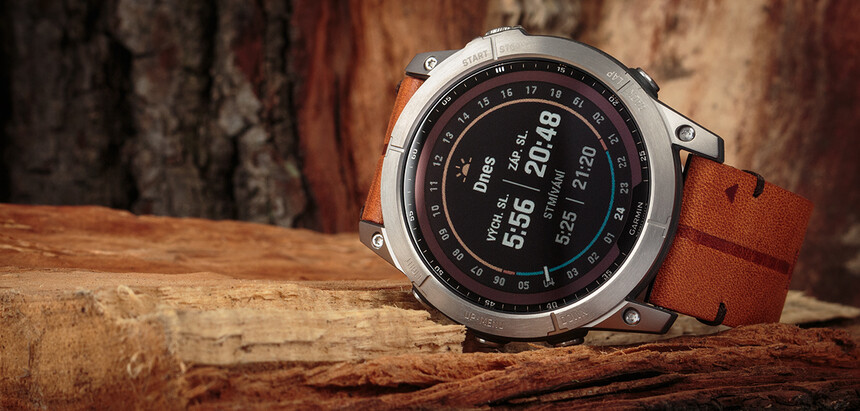Men's classicMen's
Women's classicWomen's
Smart watchesSmart
Brands
Other
Tags: Selection Guide | Garmin | Smart
15.6.2021 | 10 MIN
Watches, smartwatches in particular, differ in many ways and knowing your way in the sea of them can be quite a challenge. Some have that sensor extra, different controls and choosing something that fits your requirements takes hours of intensive research. So what is the goal of this article? To save you those hours and help you find out what you do want from your Garmin smart device and what you don't need at all, all that in the shortest possible time .

Some people want to know everything about their heart rate, some people require maps, others want to pay with the watch and listen to music, but for some people it is enough to know the number of steps they take during the day. As with everything, people are different, unique and so are their unique requirements. And what do you want from your watch? Whether you know exactly what you want or whetehr this is your first contact with a smart device, hopefully, this article will help you. Now let's do this.
If your goal is to get up from the couch and start moving, you do not necessarily need accurate measurements of sports activities, it should be enough for you to know the number of steps you take. A smart band with a pedometer could be the right match for you. But if you take sport seriously and you really want to understand your body a little more, heart rate can tell you a lot, and it can help you to get your training a bit further.
Did you know that a low resting heart rate is associated with longevity? The heart is literally our engine and its working rate says much more about our body than the work load of any other organ.
For example, athletes might have a resting heart rate below 40 beats per minute. This means that their heart is so strong that a small number of beats are enough for it to get blood throughout the whole body. This way the heart does not wear out so much and will probably be able to work for a longer time. So if your heart beats, for example, one hundred times per minute, it is a good indicator that it's wearing out unnecessarily and maybe you should do something about it.

Heart rate is most commonly used to determine aerobic and anaerobic exercise load. An aerobic exercise is associated with a low heart rate. Your body gets enough oxygen, your muscles won't stiffen as quickly, you will mainly burn fat (ideal for weight loss) and you will not feel completely destroyed after training. An anaerobic exercise is the opposite of the aerobic one. The heart works at a high frequency, the body burns sugars and a large amount of lactic acid is created, which causes the muscles to stiffen and fatigue to start faster.
For begginers, I would definitely recommend training within aerobic exercise zone. Your body will get used to the movement and gradually you will be able to run faster and longer without feeling tired. Unnecessarily high heart rate is the most common beginner's mistake, you should always check your HR. With a lower heart rate you will enjoy the exercise more, you will be able to run again the next day and it will be beneficial for your body. And that's what's important.
If your answer is similar to this, Garmin VívoFit 4 smart band may be the right choice for you. VívoFit 4 is a Garmin's lowest price band and it offers basics such as the number of steps taken, setting daily goals and sleep monitoring. Thanks to its small size and weight (26 g), you will hardly feel it on your hand, and thanks to the one-year battery life, it will be almost completely worry-free.

You take your training seriously and want to know more about your body. The lowest priced choice from Garmin is VívoSmart 4 smart band. Nice price, heart rate sensor, estimated VO2Max value and pulse oximeter (measures blood oxygenation). Additionally, it is very light (17 g) and prides itself with a week long battery life (the watch does not have a one-use battery like the band mentioned before, but a rechargeable battery).

In the range of smartwatches, I would recommend Garmin Forerunner 45, which is the least inexpensive among the newer models and, unlike VívoSmart 5, has an integrated GPS sensor for accurate route recording. Functionally, however, it is even more equipped, an example of it is the virtual trainer Garmin Coach, which will guide your training based on your fitness condition or it will show you the day's suggested workout. If this model didn't appeal to you, don't worry, because vast majority of Garmin devices have a heart rate sensor.

More than about pros and cons, this question is about your preferences. If you use the smartwatch primarily during the day in the office, the touch screen will probably not limit you in any way, and I would not be scared to say that in the "touch screen time", it will be more comfortable and faster for you. However, an advanced or elite athlete would probably never buy a watch with a touch screen.
The touch screen might have a problem when using it with sweaty hands, in the rain, cold or when you're wearing gloves. Buttons are a certainty. Whatever the weather is like, they don't care that your hands are wet, the button there will always be 100 % ready to complete the task. The same applies for when you are moving. It is harder to use a touch screen when you are running. Finding a button is just easier. Recreational athletes are exposed to such problems very rarely, but advanced and elite athletes regularly.
When choosing a way to control the watch, the most important thing is to think about the conditions in which you will use the watch most often.
If you feel more inclined towards using the touch screen, I would definitely recommend Garmin's most popular sports watch with a touch screen – VívoActive 4. Transflective LCD display (permanently lit, high readability in direct sunlight), contactless payment and music player. Sounds great, doesn't it?

An alternative is Garmin Venu 2, which has the same features and uses an AMOLED display. In comparation to the transflective LCD display, AMOLED turns off and lights up using a gesture and does not have good readability in direct sunlight, but on the other hand offers a nicer, contrasting and vividly colored display.
Whether it's because you're an advanced athlete or whether you just don't want a touch screen, I have good news for you. Garmin strongly prefers this type of control too, so you'll find buttons on most models, from the Forerunner 55, the Forerunner 255, to flagships like the Fenix 7 and the Forerunner 955. My personal favorite must be the Forerunner 255. Why? It has a low weight, contactless payment, a music player and perhaps the best price/performance ratio in the Garmin series so far.
1.6.2022
Garmin Forerunner 255/255S Review – Loaded mid-price athlete
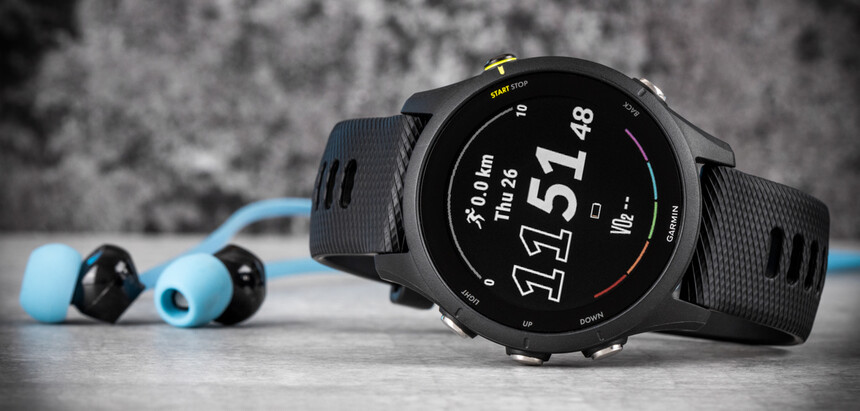
Well, this question should rather be: "Do I have a phone on me at all times?". Many Garmin devices support music players and streaming services (Spotify, Deezer and other), but for someone who always carries a phone, it's honestly completely useless. A lot of users don't even know they can control the music played on their phone with the watch. I am, on the contrary, the type of a person who likes run without a phone and enjoy the music playing in my ears. If you feel the same way, I would definitely recommend the music player.
Whether it's because you're not listening to music or you just need to control the music on your phone, the already mentioned Forerunner 55 model. It is Garmin's modern sports watch for the best price you can find.
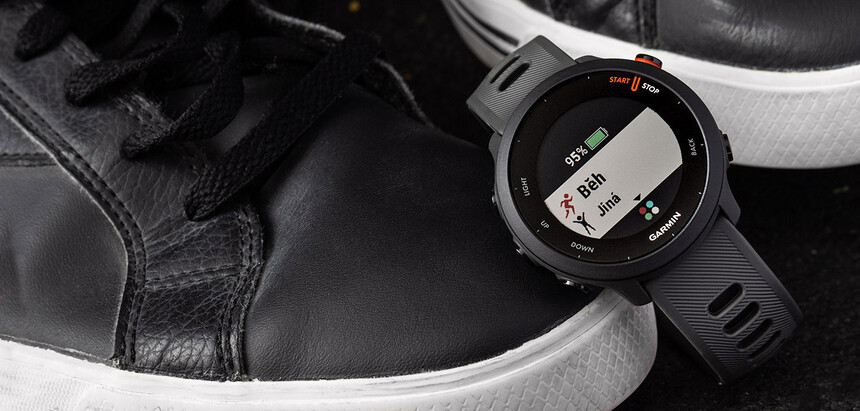
Looking at this from the perspective of price, the lowest price for a Garmin with a music player is the Garmin VívoActive 4. This piece has been on the market for three years, but its popularity has not dropped by an inch so far.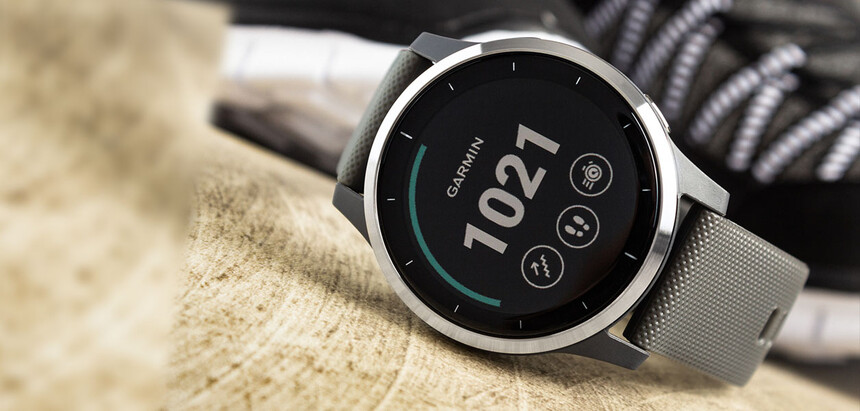
This is a similar issue as it is with the music player. If you have your phone or wallet on you all the time, it is pretty much useless for you. If you are a person who likes to go out "empty handed", it might be very practical.
However, I must point out that this is one of the functions that you will get used to quickly. There is no need to look for a phone or wallet, you just simply reach it with your hand and all is paid for.
Yes, the counter-argument could be that it is dangerous. But I have to disagree. The first time you pay during the day, the watch requires a four-digit code. The next time you pay that day, it will no longer ask for the code. Which can seem dangerous, but... Even if you remove the watch for just a few seconds, the watch will automatically recognize it and then request the code again the next time you pay.
Contactless payment is utilized in models from the VívoActive, Venu, VívoMove 3 Style lines, higher-level Forerunner models and all the newer Fenix models. The lowest-priced piece that has a contactless payment, is the Garmin Venu SQ. The version without the music player costs less than 160 EUR. For the music version, you would have to pay a bit more but the price is still very pleasant.

Yes, answearing this question with a question is not entirely adequate, but let's give it a try. Are you a curious person who is constantly exploring new places, roads and who must have a constant overview of the location on a detailed map directly from his wrist? If your answear is yes, topographic maps in your watch is something for you. On a wrist of a person who just occasionally looks at the map while hiking or uses a navigation from time to time, the watch with this equipment is quite useless. Phone, or a less expensive Garmin watches with simple arrow navigation shoud be enough for you.
Arrow navigation is the simplest type of navigation. Topographic maps, on the other hand, are the absolute top of navigation functions in smartwatches. As a golden mean, there is also point-to-point navigation, where the individual paths are displayed at least roughly. In the quality-of-the-navigation to price ratio, the clear winner is Garmin Instinct with a simpler route display, military resistance standard and the price tag under 300 EUR.
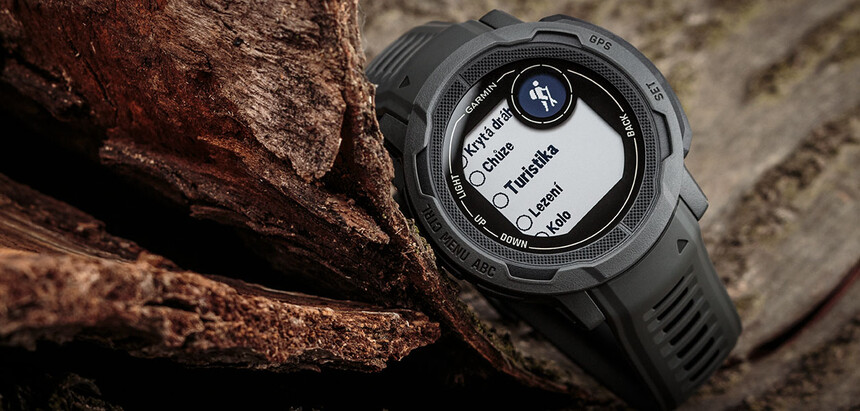
Detailed topographic maps are offered in watches within a higher price range. The favourite, top-equipped model (including topographic maps) is the Fenix 7. Many people also opt for the Tactix 7 model, same equipment, but different design. It also offers some basic military features on top.
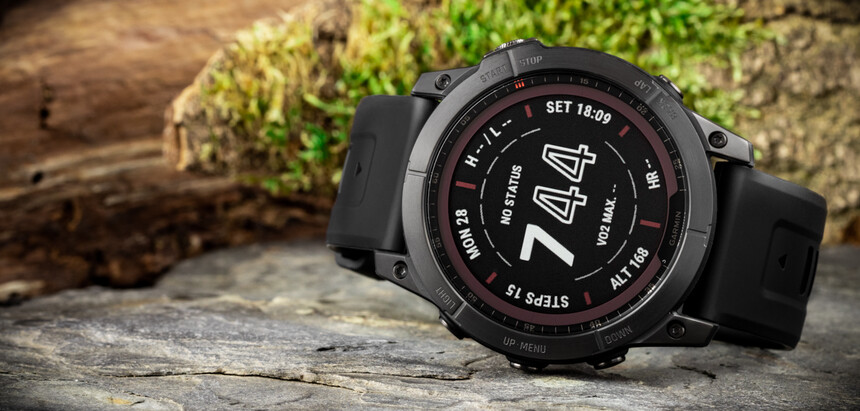
If one of your priorities is the lowest weight possible, you should opt for the Forerunner 955. The equipment is basically the same, it only lacks metal element which lowers the weight to basically the minimum.
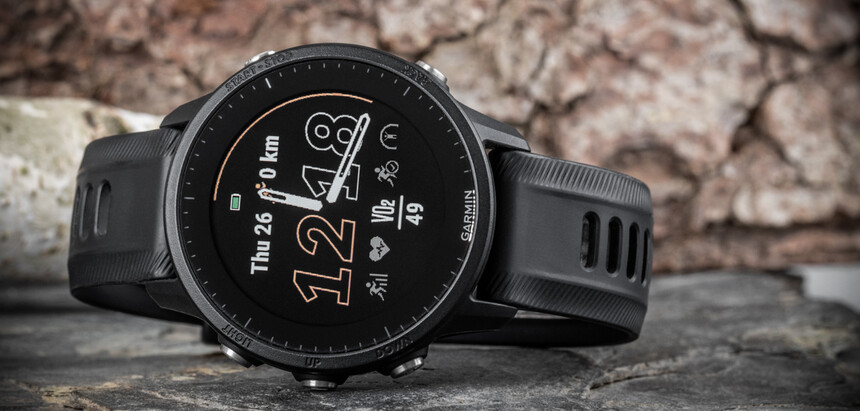
To get a better summary, I include a table with all the models and functions mentioned in the article.
| HR | Control | Display | Music player | NFC | Topographic maps | Barometer | Battery life | |
| Garmin VívoFit 4 | NO | BUTTON | tr. LCD | NO | NO | NO | NO | up to 1 year |
| Garmin VívoSmart 5 | YES | TOUCH SCREEN | OLED | NO | NO | NO | YES | up to 14 days |
| Garmin Forerunner 55 | YES | BUTTONS | tr. LCD | NO | NO | NO | NO | up to 14 days |
| Garmin Venu SQ | YES | TOUCH SCREEN | LCD | NO | YES | NO | NO | up to 6 days |
| Garmin Instinct 2 | YES | BUTTONS | tr. LCD | NO | YES* | NO | YES | up to 28 days |
| Garmin VívoActive 4 | YES | TOUCH SCREEN | tr. LCD | YES | YES | NO | YES | up to 8 days |
| Garmin Venu SQ Music | YES | TOUCH SCREEN | tr. LCD | YES | YES | NO | NO | up to 6 days |
| Garmin Forerunner 255 | YES | BUTTONS | tr. LCD | NO | NO | NO | YES | up to 14 days |
| Garmin VívoMove 3 Style | YES | TOUCH SCREEN | AMOLED | NO | YES | NO | YES | up to 5 days |
| Garmin Forerunnner 255 Music | YES | BUTTONS | tr. LCD | YES | NO | NO | NO | up to 14 days |
| Garmin Venu 2 | YES | TOUCH SCREEN | AMOLED | YES | YES | NO | YES | up to 5 days |
| Garmin Forerunner 955 | YES | BOTH | tr. LCD | YES | YES | YES | YES | up to 15 days |
| Garmin Fenix 7X Sapphire Solar | YES | BOTH | tr. LCD | YES | YES | YES | YES | up to 28 days |
| Garmin Tactix 7 | YES | BOTH | tr. LCD | YES | YES | YES | YES | up to 28 days |
* HR stands for optical heart rate sensor | the Instinct 2 offers NFC only in its solar version
A cherry on top. I want the best!
This whole article is strictly based on rationality. What do I need, what I do not need. However from time to time, we can not be amazed enough how many costumers come to our store with a simple task for us to find the best outdoor watch. Rationality aside. Just the best. That is when it's the Garmin Fenix 7X's time to shine.
And why do I think rationality goes aside? Honestly, this model has so many tweaks that that there are only a handful of people who would use its full potential. But it's simply Garmin's flagship. Heart rate sensor, button control, music player, contactless payments, topographic maps and a titanium bezel, elegant design and battery that doesn't need a charger for 3 weeks. You want it? You got it.
